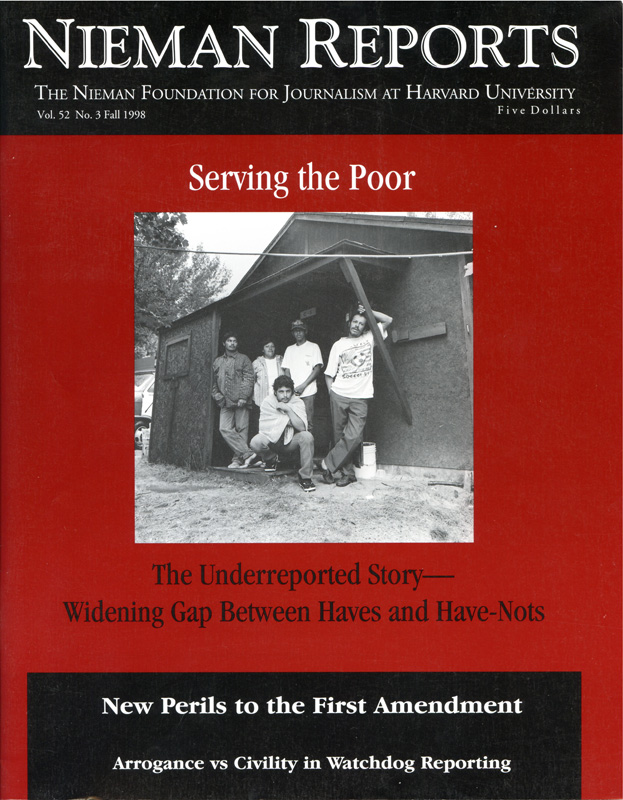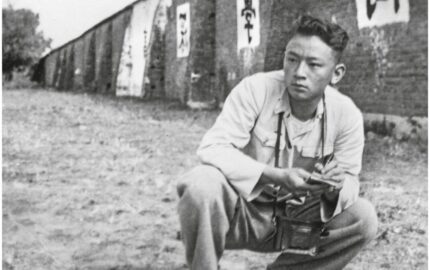
Serving the Poor
“I think a strong argument can be made that the residents of [poorer] areas are severely disadvantaged—as citizens, as workers, as consumers—by the lack of serious coverage from television and the lack of local coverage of their neighborhoods by newspapers,” said Maxwell King former Editor of The Philadelphia Inquirer. The reason, of course, is that the media, regardless of their claims of serving all the people, aim for the affluent, the audience that advertisers seek. It would seem, then, that if newspapers want to expand readership they would be worried about the growing gap between the rich and the poor.

Relatively little has been written about the struggle and rise to prominence of America’s most prodigious black newspapers. Now, with the publication of “The Baltimore Afro-American, 1892-1950,” we are provided a much-needed glimpse into an area of the past that has often been swept to the sidelines of journalism history. This is not merely the story of a newspaper that dared to call itself The Afro-American in the 19th Century—a term even W.E.B. Du Bois eschewed—but an account of institutionalized racism in Baltimore and, indeed, throughout much of U.S. society.
The need for black-owned and operated newspapers at the turn of the century was made clear by the editorial positions of even the most progressive white-owned newspapers. For example, author Howard Farrar points out that The Baltimore Sun in 1917 condemned vicious anti-black rioting in Chicago, while simultaneously appealing to blacks to “abandon for all time the foolish idea of social equality.”
Farrar’s book is divided into nine chapters, each exploring The Afro-American’s role in challenging seemingly inalterable institutionalized racism of that period. The Baltimore Afro-American practiced enthusiastically and without apology the purest forms of advocacy journalism.
During the period in question, social justice for black Americans was consistently deferred or denied by white politicians. The Afro-American’s editors, shying away from neither controversy nor danger, routinely attacked local, state and national officials who failed to properly respond to the concerns of black Americans. Consequently, it was often at odds with America’s commanders and chiefs, who, perhaps with the sole exception of Harry Truman, were solicitous of Southern Democrats. Even FDR, whose New Deal has forever identified him as a progressive, refused to support basic human rights protections for blacks embodied in anti-lynching legislation.
Even during World War II, when the U.S. government urged silence and cooperation in the battle against fascism abroad, The Afro-American continued to agitate against white supremacy at home. Moreover, it and other black newspapers were virtually the only sources of coverage about black men who were dying for their country in Europe, Asia and North Africa.
One of the most heroic acts of World War II, the downing of several Japanese aircraft during the raid on Pearl Harbor by a black messman, was grossly under-reported in the mainstream press. The Navy man, Dorie Miller, may have languished in obscurity if not for the persistent coverage and editorializing by The Afro-American and other black newspapers. In 1942, he was reluctantly awarded the Navy Cross.
Locally, The Afro-American agitated for equal pay for Baltimore teachers and for more black administrators. It editorialized against police violence, white mob lynchings, and the discriminatory use of the death penalty. The newspaper curried favor with black readers in Baltimore and other cities where The Afro-American had been established as the paper of choice. Thus, from 1940 to 1945, The Afro-American’s circulation grew 124 percent, from 105,000 to 235,000.
Though The Afro-American was influential it was not powerful. It was successful in several key battles against discriminatory policies and practices, but largely ineffective in convincing black voters to accept its political recommendations in local, state and national elections.
Unfortunately, the author repeats this point with surprising redundancy. The writing is also uneven and at times reads like a Ph.D. dissertation. Perhaps it is a reflection of the author’s background, an Assistant Professor of History at Virginia Polytechnic Institute and State University.
These imbalances, however, can be forgiven in view of the treasure of information packed into these 220 pages.
The book also focuses on personalities. The Baltimore Sun had H.L. Mencken. The Baltimore Afro-American had Ralph Matthews Sr., a tough enterprising reporter, though we really never learn enough about him to form a complete picture.
Matthews, the writer Langston Hughes and the man who went on to lead the newspaper, Carl Murphy, covered the great stories of their time: The trial of the Scottsboro Boys, Italy’s invasion of Ethiopia, the Spanish Civil War.
Still, Farrar laments the sensationalism that characterized much of The Afro-American’s style of reporting. There seemed to be no body counts, imprudent behavior or lascivious rumors too wild, or, at times, unsubstantiated, to report. Farrar cites the publication in 1948 of an inaccurate (and extremely damaging) story accusing the author Zora Neal Hurston of sexually molesting three children. In that sense, The Afro-American’s journalism was not unlike a great deal of reporting of that era.
Hayward Farrar’s manuscript comes out at a time when a much-deserved historical light is being shone on America’s black press. In February 1999, PBS will air a documentary by New York filmmaker Stanley Nelson called “Soldiers Without Swords: The Black Press.” And several struggling black newspapers today are being resuscitated by a new generation of African-American journalists.
It is ironic that The Baltimore Afro-American’s 106-year-old campaign for social and racial justice has probably led to its near obsolescence. It barely survives today with a circulation of several thousand. After the Kerner Commission reported that white segregated newsrooms and accompanying coverage helped inflame racial unrest in the 1960’s, white newspapers and broadcast media have drained off significant numbers of talented black journalists. The Baltimore Afro-American, so successful in militating against institutionalized racism, must now take on the difficult task of making itself relevant to a new breed of readers who were nourished on the fruits of progress cultivated by the reporters, publishers and editors of this important American newspaper.
Phillip W.D. Martin, a 1998 Nieman Fellow, is a freelance journalist based in Boston.


